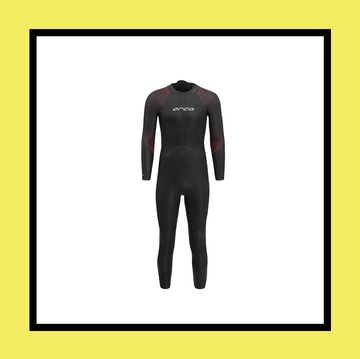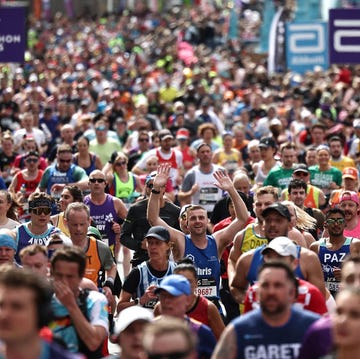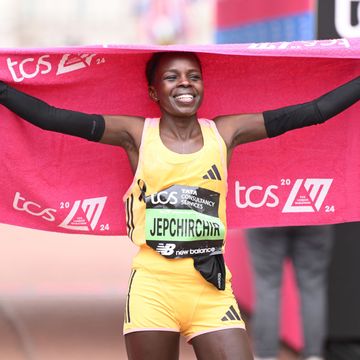Trying to improve your finishing time but only have time to run on your lunch break? You’re doing something right. Developing speed is ideal for time-pressed runners because getting faster requires short, targeted efforts.
‘If you want to get fast – and run fast – you can’t run fast for long (not really fast). So shorter sessions mean you can really focus on building intensity – moving fast and creating the stimulus for favourable adaptions,’ says Jake Dearden, Represent 247 head coach and athlete.
‘When we think about speed in running we very specifically want to spend as much time as possible at our top-end velocity – moving fast and pushing intensity. This fits the bill for a tight on time workout as you can only run fast for a certain period of time before fatigue is going to limit your ability to hit your top-end speed.’
Looking for some workout inspiration? Dearden has come up with four running-specific workouts to help build speed, even if you’re tight on time....
If you’ve only got 20 minutes
You should: run short sprints
20-minute AMRAP
200m sprints
200m jog / walk
This is about as simple as you can make a workout, says Dearden.
‘If you think about one thing in this session I want you to think about contrast. This is a speed session so I don’t really care about your average moving speed. What we want to see is a big difference between your hard efforts and your recovery and able to really max out our hard effort.
‘This session may sound quite easy but if you are really pushing the intensity of the hard effort after 3-4 rounds, you will start to question if the 200m jog / walk is the same length as the 200m hard.
‘If you’re recording this workout on a wearable, look for your highest moving speed – if you know your 5K time, you should be able to hold 1-2 minutes per km below that speed for short duration bursts like this. So, if you run 5K in, for example, 24 minutes, you should be able to hit low 4 or even into the 3 min/km realm.’
If you've only got 30 minutes
You should: run decreasing intervals
800m x 2
600m x 2
400m x 2
200m x 2
(With 90 seconds rest in between every interval)
‘As you work through this workout your rest-to-work ratio decreases which will allow the intensity and top-end speed to dial up,’ says Dearden. ‘Try to work on bringing those average speeds down 10-30 seconds per round depending on how dialled in you are on your own pace.
‘This is also a way of learning to run with negative splits – these are runs where you gradually reduce your splits as the run progresses, but with the built-in rests here you should be able to manage this. Remember, we are interested in speed, so by the time you get to the 200m efforts you should be a 8-10/10 intensity.’
If you’ve only got 45 minutes
You should: shorten the intervals and increase the rest
20m
40m
60m
80m
100m
x3
(With walk recovery between each distance and 3-minute rest between sets. Each set should be faster than the last.)
Dearden suggests setting this up in a park or on a football or rugby field with cones set out at each distance, but you can also do it by using trees as the benchmark and running in between them.
‘Make sure you’ve warmed up really well – add in some more hamstring activation movements as you are really going to be going for it in this session – it’s only 900m of total running, but you will be at sprint speed the whole time,’ he says.
Getting faster isn’t just about running long, he reminds us – ‘speed exists on a spectrum and sessions can be 100% speed focused or can start to blend into anaerobic recovery with an element of conditioning and repeat efforts. This one is 100% speed – I want you to think about building to one flat-out 100m effort as your final sprint, the first 2 sets should be around a 7-9 intensity with your hardest reserved for the third.’
If you’ve got an hour (or more)
You should: go long
AMRAP
2km fast
1km jog
For this last workout Dearden advises breaking each of the 2k fast intervals down mentally into 400m sections – ‘you are going to push for negative splits, getting 10-15s faster on your splits every 400m. Then, when you hit the jog I want you to completely drop your speed. You should be at least 1-2 min slower on your splits than you would be for a 5k effort.’
Top tips on how to squeeze runs in on a busy schedule
1.Have a goal
When you’re short on time, it may seem easier to just give exercise a miss completely (rather than halfheartly squeezing half a session in). This is why it’s good to have a set goal to work towards – such as a PB you’ve set yourself or a race to enter. ‘Whatever it might be, work backwards from it in a manageable training block of 4-6 weeks, so you know sessions you want to hit to get there,’ says Dearden.
2. Plan, plan, plan
Map out your training for the following week the Sunday before – so you know exactly when you’re going to fit in your long run, tempo session and easy run within the working week. ‘Plan those sessions into your diary – block it out so you can’t get lunchtime meetings put in,’ he adds.
3. Make it hard to miss
When it comes to making time for your sessions, organisation is key. ‘Do everything you can to make it as easy as possible to hit that session,’ says Dearden – who suggests packing your bag the night before with your running gear ready to go, and even prepping a post-run snack, ‘so you don’t have an excuse when you are rushing in the morning.’













